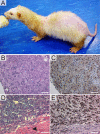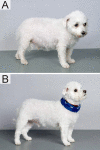Animal models of adrenocortical tumorigenesis
- PMID: 22100615
- PMCID: PMC3288624
- DOI: 10.1016/j.mce.2011.09.045
Animal models of adrenocortical tumorigenesis
Abstract
Over the past decade, research on human adrenocortical neoplasia has been dominated by gene expression profiling of tumor specimens and by analysis of genetic disorders associated with a predisposition to these tumors. Although these studies have identified key genes and associated signaling pathways that are dysregulated in adrenocortical neoplasms, the molecular events accounting for the frequent occurrence of benign tumors and low rate of malignant transformation remain unknown. Moreover, the prognosis for patients with adrenocortical carcinoma remains poor, so new medical treatments are needed. Naturally occurring and genetically engineered animal models afford a means to investigate adrenocortical tumorigenesis and to develop novel therapeutics. This comparative review highlights adrenocortical tumor models useful for either mechanistic studies or preclinical testing. Three model species - mouse, ferret, and dog - are reviewed, and their relevance to adrenocortical tumors in humans is discussed.
Copyright © 2011 Elsevier Ireland Ltd. All rights reserved.
Figures


Similar articles
-
Animal models of adrenocortical tumorigenesis.Endocrinol Metab Clin North Am. 2015 Jun;44(2):297-310. doi: 10.1016/j.ecl.2015.02.003. Endocrinol Metab Clin North Am. 2015. PMID: 26038202 Review.
-
Mouse models of adrenocortical tumors.Mol Cell Endocrinol. 2016 Feb 5;421:82-97. doi: 10.1016/j.mce.2015.11.031. Epub 2015 Dec 8. Mol Cell Endocrinol. 2016. PMID: 26678830 Free PMC article. Review.
-
Review paper: origin and molecular pathology of adrenocortical neoplasms.Vet Pathol. 2009 Mar;46(2):194-210. doi: 10.1354/vp.46-2-194. Vet Pathol. 2009. PMID: 19261630 Free PMC article. Review.
-
Adrenocortical stem and progenitor cells: implications for adrenocortical carcinoma.Mol Cell Endocrinol. 2012 Mar 31;351(1):2-11. doi: 10.1016/j.mce.2011.12.006. Epub 2012 Jan 13. Mol Cell Endocrinol. 2012. PMID: 22266195 Free PMC article. Review.
-
Update on in-vivo preclinical research models in adrenocortical carcinoma.Curr Opin Endocrinol Diabetes Obes. 2020 Jun;27(3):170-176. doi: 10.1097/MED.0000000000000543. Curr Opin Endocrinol Diabetes Obes. 2020. PMID: 32304391 Free PMC article. Review.
Cited by
-
GATA4 is a critical regulator of gonadectomy-induced adrenocortical tumorigenesis in mice.Endocrinology. 2012 Jun;153(6):2599-611. doi: 10.1210/en.2011-2135. Epub 2012 Mar 28. Endocrinology. 2012. PMID: 22461617 Free PMC article.
-
GATA factors in endocrine neoplasia.Mol Cell Endocrinol. 2016 Feb 5;421:2-17. doi: 10.1016/j.mce.2015.05.027. Epub 2015 May 28. Mol Cell Endocrinol. 2016. PMID: 26027919 Free PMC article. Review.
-
Adrenocortical zonation, renewal, and remodeling.Front Endocrinol (Lausanne). 2015 Mar 5;6:27. doi: 10.3389/fendo.2015.00027. eCollection 2015. Front Endocrinol (Lausanne). 2015. PMID: 25798129 Free PMC article. Review.
-
Establishment of a mouse xenograft model of metastatic adrenocortical carcinoma.Oncotarget. 2017 Apr 7;8(31):51050-51057. doi: 10.18632/oncotarget.16909. eCollection 2017 Aug 1. Oncotarget. 2017. PMID: 28881628 Free PMC article.
-
Hereditary Endocrine Tumor Registries.J Endocr Soc. 2022 Dec 23;7(3):bvac194. doi: 10.1210/jendso/bvac194. eCollection 2023 Jan 6. J Endocr Soc. 2022. PMID: 36632485 Free PMC article.
References
-
- Auchus RJ. Overview of dehydroepiandrosterone biosynthesis. Semin Reprod Med. 2004;22:281–288. - PubMed
-
- Benchekroun G, de Fornel-Thibaud P, Lafarge S, Gomez E, Begon D, Delisle F, Moraillon R, Heripret D, Maurey C, Rosenberg D. Trilostane therapy for hyperadrenocorticism in three dogs with adrenocortical metastasis. Vet Rec. 2008;163:190–192. - PubMed
-
- Bernichtein S, Alevizaki M, Huhtaniemi I. Is the adrenal cortex a target for gonadotropins? Trends Endocrinol Metab. 2008;19:231–238. - PubMed
Publication types
MeSH terms
Grants and funding
LinkOut - more resources
Full Text Sources
Molecular Biology Databases
Miscellaneous

